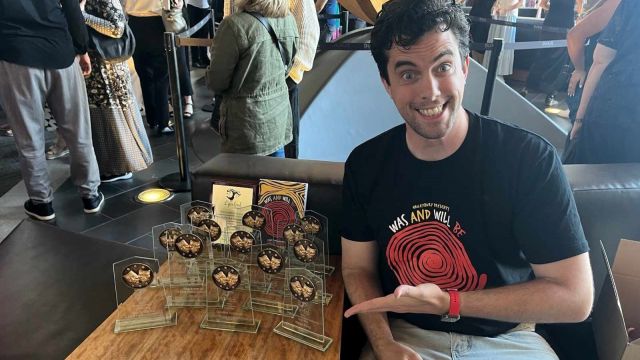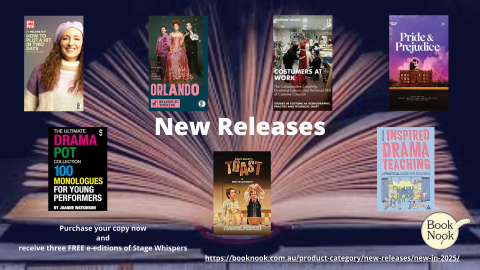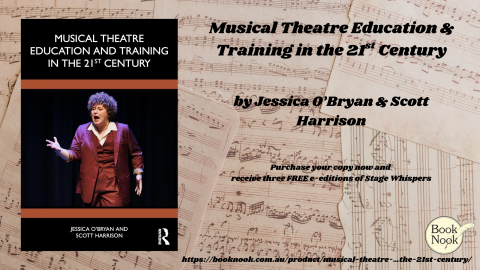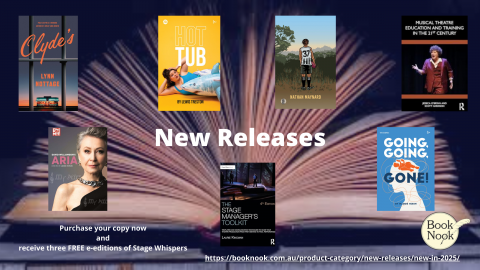Was and Will Be - Script Excerpt

A First Nations anthology by Tracey Rigney, Brodie Murray and Tom Molyneux has been published by Currency Press. The monologues, dialogues, choruses and movement sequences are written for performance by Indigenous and non-Indigenous actors. The work, conceived by Haileybury College Drama Teacher Nick Waxman, picked up seven Lyrebird Awards for the World Premiere season.
Yidaki / Didgeridoo
Deep listening. Gulpa Ngawal. Listening to the earth and surroundings.
Hear the Mile. Sounds of the currents and ripples.
Crouching underfoot like a warrior.
Toes sinking into wet earth. Listening to the earth.
The calls of pelicans close down river. The hum of Country all around.
Elders often speak about the sacred practice of deep listening.
When incorporating the sound of the yidaki and closing your eyes.
The sound travels as a vibration. Across the body and across Country.
Remembering those night-time campfires in Balranald on Yanga Lake.
The sounds of birds and wildlife.
I sit, amazed. Watching them play the didgeridoo and listening to music.
Telling us about the sacred sites along the lake.
Yarns passed down from father to fathers.
We hear about Bes Murray. Worked on Yanga station for 58 years. Old ways, survival. Sunsets and sunrise. The sounds of the yidaki are ancient.
Back from the time of the dreaming.
It brings the old people close to us. Smells of the campfire, gum leaves and red-hot coals. Coals burning in the night. While we stared up at the night-time sky above.
Constellations reflected in the ripples of Yanga Lake.
I imagine generations ago when the Ancestors walked along the banks of Yanga Lake.
The Muthi Muthi mob. How pristine clear the lake was.
A plentiful supply of freshwater fish and clams all year around.
The practice of Gulpa Ngawal cleanses our spirit.
Connects us from past to present. To our Ancestors and the spirits from the dreaming. Senses tuned to Country around me.
Deep listening is tuning in to the river, the open planes, the river red gums,
the pelican flying on the other side of the river.
It is a part of our spirit if we choose to listen.
Encourage students to use slow, deliberate movements to mimic the act of deep listening, with gestures that represent connecting with the earth and surroundings. Movements can
illustrate the sinking of toes into wet earth, the calls of pelicans and the vibrations of the didgeridoo.
Soundscapes
Incorporate natural sounds such as water ripples, bird calls and didgeridoo music to create an immersive auditory experience using instruments or voices.
Symbolic Prop Use a didgeridoo as a central prop, allowing students to interact with it, symbolising the connection to their Ancestors and the earth. The prop can be passed among students to represent the sharing of cultural heritage and the continuity of tradition.
Tableau Vivant Create a series of still images or tableaux that capture key moments, such as sitting around the campfire, listening to the didgeridoo and reflecting by the lake. Use body language and facial expressions to convey the sense of wonder, reverence and connection to the land and Ancestors.
Choral Reading Perform a group recitation of the narrative, with students embodying the sounds of the Yidaki, the sounds of nature and the storyteller.
The Marngrook
I close my eyes and tune in to the land around me.
Wamba Wamba Country. The Country around me.
Holding me closely.
Sun sets across Mile; casting distant ripples along the surface.
I hear echoes of the past. Children playing. Men and women laughing.
Scent of gum leaves and roasting kangaroo meat. Taking me back
hundreds of generations. Back to the old ways. Old people.
In Victoria, the mobs created the game of AFL, called Marngrook.
Young boys after a hunt. Early afternoon. They buried the possum
skin, the Marngrook, in the dirt. Giving it back to Country. Back to the earth.
Then they’d uncover it, bring it up from the ground.
Ready to play the old game of Marngrook again.
Mobs would play it for hours on end. Sometimes even days.
Bodies moving gracefully around the earth. Athletes moving in synchronicity.
Dancing and connected to each other and the Country around them.
Marngrook was and is the beginning of the game we now call AFL. Generations later.
I watch Bobby Hill move with a confidence and grace around the ground.
On the biggest stages of the game. It’s like he has a sixth sense.
He just knows where the ball is going. Where it’s been and where it’s going to be.
He’s in tune with the land as well as the players around him.
Takes me back to the great Grand Final against the Lions.
Bobby Hill against an unimaginable amount of pressure proved himself as best on ground to give the Pies the flag!
Bobby celebrates his goals with dance and movement. It is magical experience just to witness his connection to both the game and his culture.
Takes me back to how the young fellas would have played Marngrook in Victoria.
Back in the old times. Along the Mile (Murray River), young boys like Bobby anticipating the possum skin Marngrook. Catching it and spinning.
Tips for Interpretation
Use dance and movement to depict the flow and grace of Marngrook players, both past and present. Movements can illustrate the burying and uncovering of the Marngrook, the synchronicity of the players and the celebratory dances of modern players like Bobby Hill.
Soundscapes Incorporate sounds of nature such as rustling gum leaves, distant laughter and echoes of ancient times to create an immersive auditory experience. Use recordings of traditional Aboriginal music and didgeridoo to enhance the atmosphere and cultural connection.
Symbolic Prop Use a replica of the Marngrook (possum skin ball) as a central prop, allowing students to interact with it, symbolising the continuity of the game from ancient times to the present. The prop can be passed among students to represent the sharing of cultural heritage and the evolution of the game.
Tableau Vivant Create a series of still images or tableaux that capture key moments, such as young boys playing Marngrook, the ceremonial aspects of the game and modern AFL players in action. Use body language and facial expressions to convey the joy, pride and connection
to the land and culture.
Choral Reading Perform a group recitation of the narrative, with students embodying the voices of the past and present, narrating the story of Marngrook and its significance. The collective voice, dispersed around the room like a crowd at the football could enhance the sense of continuity and shared heritage, reinforcing the themes of respect and admiration for the game and its players.
Buy a copy at Book Nook. https://booknook.com.au/product/was-and-will-be/
Licenced by David Spicer Productions. https://www.davidspicer.com.au/






